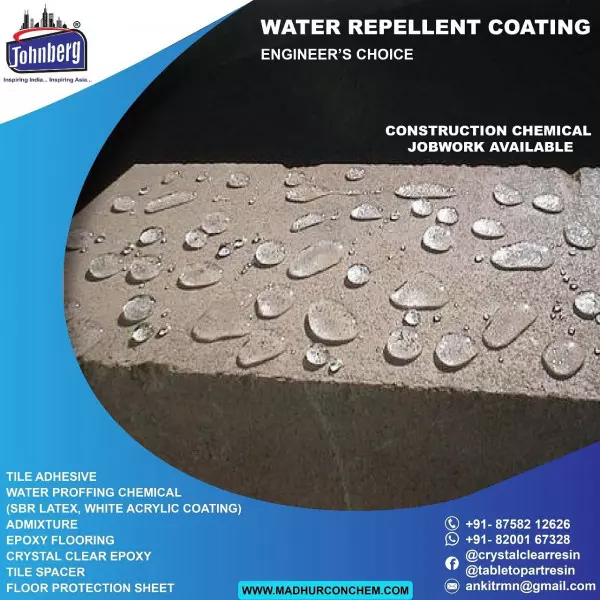- Home
- About Us
- Products
- Resin Furniture
- 3D Epoxy Flooring Service
- Resin Table Top
- Wooden Epoxy Resin Table Top
- Metallic Epoxy Flooring Service
- Conception Chemical Consultants
- Chemical Consultancy For Construction
- Construction Chemical Consultant
- Tile Grout
- Foundation Grout Consultant
- Paver Block Chemical Consultant
- Waterproofing Chemical Consultant
- Epoxy Pigment Consultant
- Heat Reflective Coating
- Water Repellent Coating
- Epoxy Grout
- Chemical Consultant
- Industrial Chemical
- Construction Chemical
- Epoxy Resin
- Epoxy Coating
- Polyester Resin
- Joint Sealants
- Cristal Clear Epoxy Resin And Hardner
- Construction Chemicals
- Polycarboxylate Ether And Liquid
- Solvent Cement
- Tile Protection Sheet
- Water Reducing Superplasticizer
- Epoxy Resin And Hardeners
- Two Component Waterproof Coating
- Epoxy Floor Coatings
- Casting Resin
- Sbr Latex Polymer
- Epoxy Grout Formulations
- Epoxy Resin Tabletops
- Tile Spacers
- Tile Levelling Spacers
- Industrial Night Vision Epoxy Grout
- Sbr Latex
- Johnberg Marble Polishing Liquid
- Acrylic Elastomeric Coating
- Weber Tile Adhesives
- Decorative Arts
- Resinic Crafts
- PU Flexible Tile Adhesive
- Resin Pressed Flowers
- Dry Pressed Flower
- Epoxy Putty
- Resin Furniture
- Services
- Updates
- Gallery
- Contact Us
Water Repellent Additive Service For Visually Immersive Surfaces Mangalore
Details of Water Repellent Additive
Water repellent additives are substances added to materials—like concrete, textiles, coatings, or wood—to reduce water absorption and improve moisture resistance. These additives work by altering the surface energy or filling pores to prevent water from penetrating. Here’s a detailed overview:
Types of Water Repellent Additives
1. Silicone-Based Additives
Examples: Polydimethylsiloxane (PDMS), Silanes, Siloxanes
Applications: Concrete, masonry, textiles
Mechanism: Form a hydrophobic (water-hating) layer on surfaces
Pros: Long-lasting, UV-stable, breathable
Cons: Higher cost compared to some alternatives
2. Wax-Based Additives
Examples: Paraffin wax, microcrystalline waxes
Applications: Wood, leather, paper
Mechanism: Coats pores to block water
Pros: Low cost, easy to apply
Cons: Can affect breathability; less durable
3. Fluorocarbon-Based Additives (less common today due to environmental concerns)
Examples: Perfluorinated compounds (PFCs)
Applications: High-performance textiles, outdoor gear
Mechanism: Repels both water and oil
Pros: Very effective at repelling both water and stains
Cons: Expensive, persistent environmental pollutants
4. Silicate-Based Additives
Examples: Sodium silicate, lithium silicate
Applications: Concrete sealers
Mechanism: React chemically with calcium hydroxide in concrete to block pores
Pros: Durable, penetrative
Cons: Slower action, mainly used for mineral substrates
Applications
Industry Use Case
Construction Concrete sealers, waterproofing coatings
Textiles Outdoor clothing, tents, upholstery
Wood Decking, furniture, fences
Paints/Coatings Exterior paints, automotive coatings
Paper Food packaging, cardboard
Mechanism of Action
Most water repellent additives function by:
Reducing Surface Energy: Making the surface less attractive to water molecules.
Pore Blocking: Filling or lining pores to prevent capillary absorption.
Forming Protective Layers: Creating a continuous hydrophobic barrier.
Performance Considerations
Durability: UV resistance, abrasion resistance, wash-out resistance
Environmental Impact: Biodegradability, toxicity (fluorinated compounds are a concern)
Compatibility: With substrates and other additives
Appearance: Some additives may alter gloss or texture
Offered Product
Water Repellent Additive
BrandjohnbergTypesSilicone ResinsPackaging Size10 KgApplication SurfaceConcretePackaging TypeCanTypeLiquidCategoryWaterproofing CoatingGrade StandardAnalytical GradeWorking Temperature25CMadhur Water Repellent Additive Admixture System Is Made Up Of Three Individually Formulated, Polymeric Additives.Specification:Madhur -208 Is A Liquid Water-repellent And Efflorescence Control Admixture That Is Specially Formulated For Use In The Manufacture Of Concrete Masonry Units (CMUs) As Well As Other "dr... Read moreWater Repellent Coating Supplier In Mysore
Water Repellent Coating Is A Protective Layer Applied To Surfaces To Reduce The Absorption Of Water.It Creates A Barrier That Allows Water To Bead And Roll Off Instead Of Soaking In This Coating Helps Protect Materials From Moisture Damage Staining And Wear.It Is Commonly Used On Fabric Glass Metal Wood And Concrete To Extend Durability And Maintain Appearance Continue


